Magma Mixing Origin for the Menyuan Granodioritic Pluton in the North Qilian Orogenic Belt, China
Abstract
:1. Introduction
2. Geological Background
3. Petrology
4. Analytical Methods
5. Results
5.1. Mineral Composition
5.1.1. Plagioclase
5.1.2. Amphibole
5.2. Zircon U-Pb Geochronology
5.3. Whole-Rock Geochemistry
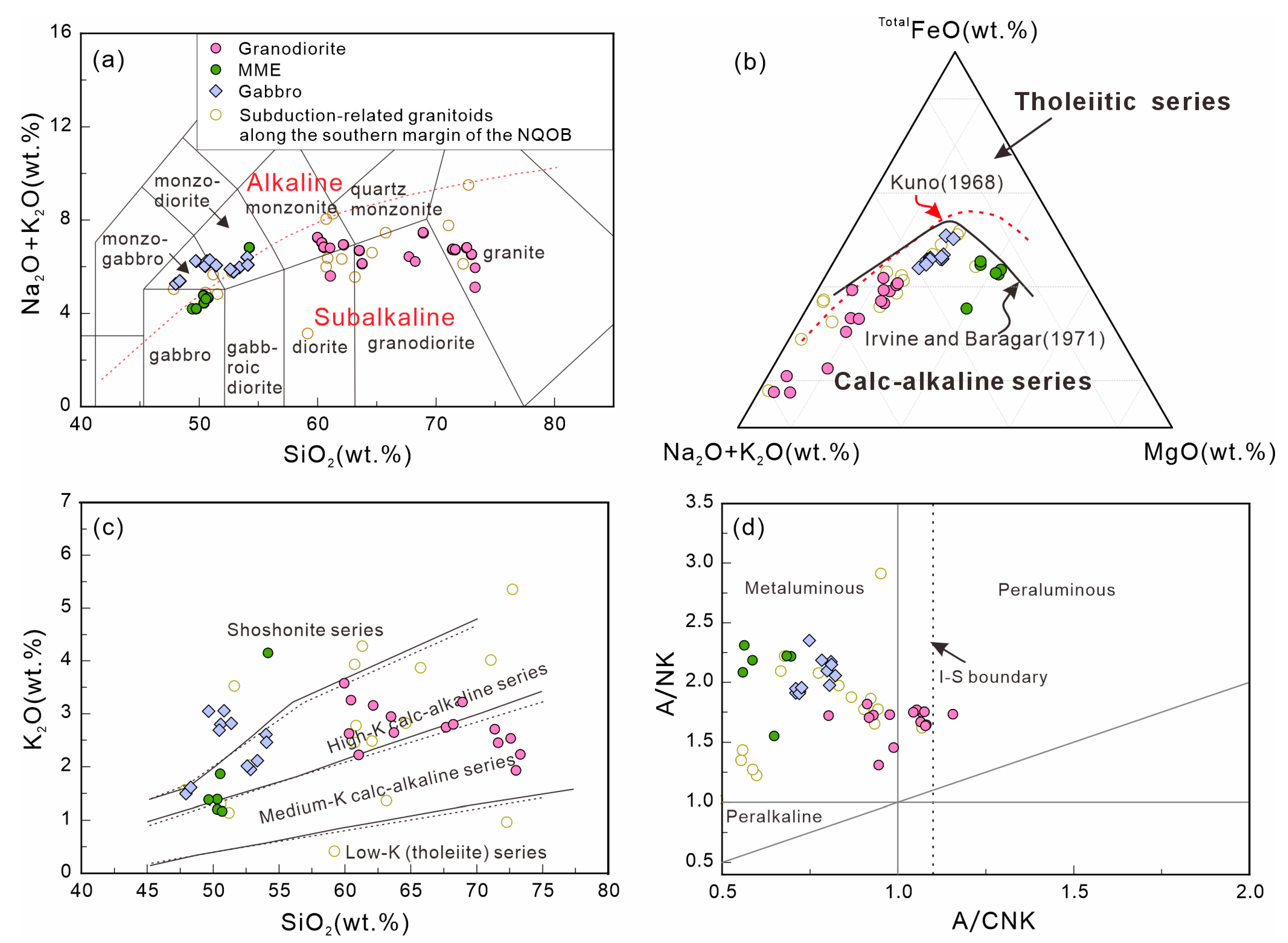

5.4. Zircon Hf and Whole-Rock Sr-Nd Isotopes

6. Discussion
6.1. Petrogenesis and Source Nature of the Menyuan Granodioritic Pluton
6.1.1. Petrogenesis of the Menyuan Granodioritic Pluton
6.1.2. Source Nature of the Menyuan Granodioritic Pluton
6.2. Geodynamic Implication for the Menyuan Granodioritic Pluton
7. Conclusions
Supplementary Materials
Author Contributions
Funding
Data Availability Statement
Conflicts of Interest
Appendix A
Appendix A.1. LA-ICP-MS Zircon U-Pb Dating
Appendix A.2. Zircon Lu-Hf Isotope Analysis
Appendix A.3. Whole-Rock Geochemical
Appendix A.4. Whole-Rock Sr-Nd Isotopes
Appendix A.5. Mineral Analysis
References
- Kumar, S.; Rino, V.; Pal, A.B. Field Evidence of Magma Mixing from Microgranular Enclaves Hosted in Palaeoproterozoic Malanjkhand Granitoids, Central India. Gondwana Res. 2004, 7, 539–548. [Google Scholar] [CrossRef]
- Turnbull, R.; Weaver, S.; Tulloch, A.; Cole, J.; Handler, M.; Ireland, T. Field and geochemical constraints on mafic–felsic interactions, and processes in high-level arc magma chambers: An example from the Halfmoon Pluton, New Zealand. J. Petrol. 2010, 51, 1477–1505. [Google Scholar] [CrossRef]
- Wiebe, R.A.; Hawkins, D.P. Growth and Impact of a Mafic-Silicic Layered Intrusion in the Vinalhaven Intrusive Complex, Maine. J. Petrol. 2015, 56, 273–298. [Google Scholar] [CrossRef]
- Flinders, J.; Clemens, J.D. Non-linear dynamics, chaos, complexity and enclaves in granitoid magmas. Earth Environ. Sci. Trans. R. Soc. Edinb. 1996, 87, 217–223. [Google Scholar]
- Ortiz, A.; Becchio, R.; Juárez, S.; Suzaño, N.; Hauser, N.; Sola, A.; Bardelli, L.; Simón, V.; Quiroga, M.; Bordese, S. Magma mixing, zircon U–Pb ages and Hf isotopes: Insights for the Miocene magmatic plumbing system in the Soroche Porphyry, Puna Argentina, Central Andes. J. S. Am. Earth Sci. 2021, 109, 103291. [Google Scholar] [CrossRef]
- Wilcox, R.E. The Idea of Magma Mixing: History of a Struggle for Acceptance. J. Geol. 1999, 107, 421–432. [Google Scholar] [CrossRef]
- Barbarin, B. Mafic magmatic enclaves and mafic rocks associated with some granitoids of the central Sierra Nevada batholith, California: Nature, origin, and relations with the hosts. Lithos 2005, 80, 155–177. [Google Scholar] [CrossRef]
- Kumar, S.; Bora, S.; Sharma, U.K.; Yi, K.; Kim, N. Early Cretaceous subvolcanic calc-alkaline granitoid magmatism in the Nubra-Shyok valley of the Shyok Suture Zone, Ladakh Himalaya, India: Evidence from geochemistry and U–Pb SHRIMP zircon geochronology. Lithos 2017, 277, 33–50. [Google Scholar] [CrossRef]
- Renjith, M.L.; Charan, S.N.; Subbarao, D.V.; Babu, E.; Rajashekhar, V.B. Grain to outcrop-scale frozen moments of dynamic magma mixing in the syenite magma chamber, Yelagiri Alkaline Complex, South India. Geosci. Front. 2014, 5, 801–820. [Google Scholar] [CrossRef]
- Paterson, S.R.; Pignotta, G.S.; Vernon, R.H. The significance of microgranitoid enclave shapes and orientations. J. Struct. Geol. 2004, 26, 1465–1481. [Google Scholar] [CrossRef]
- Castro, A.; Moreno-Ventas, I.; de la Rosa, J.D. H-type (hybrid) granitoids: A proposed revision of the granite-type classification and nomenclature. Earth-Sci. Rev. 1991, 31, 237–253. [Google Scholar] [CrossRef]
- Didier, J.; Barbarin, B. Enclaves and Granite Petrology, Developments in Petrology; Elsevier Science: Amsterdam, The Netherlands, 1991. [Google Scholar]
- Fernández, C.; Castro, A. Mechanical and structural consequences of magma differentiation at ascent conduits: A possible origin for some mafic microgranular enclaves in granites. Lithos 2018, 320–321, 49–61. [Google Scholar] [CrossRef]
- Chappell, B.W.; Wyborn, D. Origin of enclaves in S-type granites of the Lachlan Fold Belt. Lithos 2012, 154, 235–247. [Google Scholar]
- Vernon, R.H. Restite, xenoliths and microgranitoid enclaves in granites. J. Proc. R. Soc. N. S. W. 1983, 116, 77–103. [Google Scholar]
- Acosta-Vigil, A.; Buick, I.; Hermann, J.; Cesare, B.; Rubatto, D.; London, D.; Morgan, G.B.V.I. Mechanisms of Crustal Anatexis: A Geochemical Study of Partially Melted Metapelitic Enclaves and Host Dacite, SE Spain. J. Petrol. 2010, 51, 785–821. [Google Scholar] [CrossRef]
- Chappell, B.W.; White, A.J.R.; Wyborn, D. The Importance of Residual Source Material (Restite) in Granite Petrogenesis. J. Petrol. 1987, 28, 1111–1138. [Google Scholar] [CrossRef]
- Collins, W.J. Evaluation of petrogenetic models for Lachlan Fold Belt granitoids: Implications for crustal architecture and tectonic models. Aust. J. Earth Sci. 1998, 45, 483–500. [Google Scholar]
- Dahlquist, J.A. Mafic microgranular enclaves: Early segregation from metaluminous magma (Sierra de Chepes), Pampean Ranges, NW Argentina. J. S. Am. Earth Sci. 2002, 15, 643–655. [Google Scholar]
- Donaire, T.; Pascual, E.; Pin, C.; Duthou, J.-L. Microgranular enclaves as evidence of rapid cooling in granitoid rocks: The case of the Los Pedroches granodiorite, Iberian Massif, Spain. Contrib. Mineral. Petrol. 2005, 149, 247–265. [Google Scholar]
- Huang, H.; Niu, Y.L.; Nowell, G.; Zhao, Z.D.; Yu, X.H.; Zhu, D.C.; Mo, X.X.; Ding, S. Geochemical constraints on the petrogenesis of granitoids in the East Kunlun Orogenic belt, northern Tibetan Plateau: Implications for continental crust growth through syn-collisional felsic magmatism. Chem. Geol. 2014, 370, 1–18. [Google Scholar] [CrossRef]
- Niu, Y.L.; Zhao, Z.D.; Zhu, D.C.; Mo, X.X. Continental collision zones are primary sites for net continental crust growth–A testable hypothesis. Earth-Sci. Rev. 2013, 127, 96–110. [Google Scholar] [CrossRef]
- Rodríguez, C.; Pereira, M.F.; Martí, J.; Bach, N.; Scahmuells, N. Ultra-high temperatures recorded in parental magmas from hybrid zones. GSA Bull. 2025. [Google Scholar] [CrossRef]
- Rodríguez, C.; Aragón, E.; Díaz-Alvarado, J.; Castro, A.; Pedreira, R.; Sánchez-Navas, A.; Martí, J. Fractionation by compositional magma splitting: An example from Cerro Munro, Argentina. Lithos 2021, 400–401, 106396. [Google Scholar] [CrossRef]
- Chen, B.; Chen, Z.C.; Jahn, B.M. Origin of mafic enclaves from the Taihang Mesozoic orogen, north China craton. Lithos 2009, 110, 343–358. [Google Scholar] [CrossRef]
- Guo, F.; Nakamuru, E.; Fan, W.; Kobayoshi, K.; Li, C. Generation of Palaeocene Adakitic Andesites by Magma Mixing; Yanji Area, NE China. J. Petrol. 2007, 48, 661–692. [Google Scholar] [CrossRef]
- Plail, M.; Edmonds, M.; Woods, A.W.; Barclay, J.; Humphreys, M.C.S.; Herd, R.A.; Christopher, T. Mafic enclaves record syn-eruptive basalt intrusion and mixing. Earth Planet. Sci. Lett. 2018, 484, 30–40. [Google Scholar]
- Abdel-Karim, A.-A.M.; Azer, M.K.; Mogahed, M.M. Neoproterozoic concentric intrusive complex of gabbro-diorite-tonalite-granodiorite association, Rahaba area, southern Eastern Desert of Egypt: Implications for magma mixing of arc intrusive rocks. Lithos 2021, 404–405, 106423. [Google Scholar] [CrossRef]
- Mandon, C.L.; Christenson, B.W.; Seward, T.M.; Schipper, C.I. Magma mixing, degassing and late sulfide saturation: Insights into the 1976–2000 eruptive sequence at White Island, New Zealand. J. Volcanol. Geotherm. Res. 2021, 417, 107299. [Google Scholar] [CrossRef]
- Perugini, D. What is Magma Mixing? The Mixing of Magmas: Field Evidence, Numerical Models, Experiments; Springer: Cham, Switzerland, 2021; pp. 3–12. [Google Scholar]
- Chen, S.; Niu, Y.; Li, J.; Sun, W.; Zhang, Y.; Hu, Y.; Shao, F. Syn-collisional adakitic granodiorites formed by fractional crystallization: Insights from their enclosed mafic magmatic enclaves (MMEs) in the Qumushan pluton, North Qilian Orogen at the northern margin of the Tibetan Plateau. Lithos 2016, 248–251, 455–468. [Google Scholar] [CrossRef]
- Holden, P.; Halliday, A.N.; Stephens, W.E. Neodymium and strontium isotope content of microdiorite enclaves points to mantle input to granitoid production. Nature 1987, 330, 53–56. [Google Scholar]
- Song, S.G.; Niu, Y.L.; Su, L.; Xia, X.H. Tectonics of the North Qilian orogen, NW China. Gondwana Res. 2013, 23, 1378–1401. [Google Scholar] [CrossRef]
- Tao, L.; Zhang, H.; Wu, J.; Zhou, X.; Zhang, L. Magma Generation of Magnetite-Rich Intermediate-Mafic Rocks and Its Mantle Processes in the Southwestern Alxa Block, NW China. J. Earth Sci. 2022, 33, 161–176. [Google Scholar] [CrossRef]
- Chen, Y.X.; Song, S.G.; Niu, Y.l.; Wei, C.J. Melting of continental crust during subduction initiation: A case study from the Chaidanuo peraluminous granite in the North Qilian suture zone. Geochim. Cosmochim. Acta 2014, 132, 311–336. [Google Scholar] [CrossRef]
- Fu, C.; Yan, Z.; Aitchison, J.C.; Xiao, W.; Buckman, S.; Wang, B.; Li, W.; Li, Y.; Ren, H. Multiple subduction processes of the Proto-Tethyan Ocean: Implication from Cambrian intrusions along the North Qilian suture zone. Gondwana Res. 2020, 87, 207–223. [Google Scholar] [CrossRef]
- Peng, Y.B.; Yu, S.Y.; Zhang, J.X.; Li, S.Z.; Tong, L.X.; Sun, D.Y. Early Paleozoic arc magmatism and metamorphism in the northern Qilian Block, western China: Petrological and geochronological constraints. Geol. J. 2017, 52, 339–364. [Google Scholar] [CrossRef]
- Peng, Y.B.; Yu, S.Y.; Zhang, J.X.; Li, Y.S.; Li, S.Z.; Lv, P. Building a continental arc section: Constraints from Paleozoic granulite-facies metamorphism, anatexis, and magmatism in the northern margin of the Qilian Block, northern Tibet Plateau. GSA Bull. 2022, 134, 1301–1318. [Google Scholar] [CrossRef]
- Qiao, J.R.; Dong, J.; Song, S.G.; Allen, M.B.; Wang, C.; Xia, X.H.; Su, L. Development of a Modern-Style Trench-Arc-Backarc System in the Proto-Tethys Ocean (Qilian Orogenic Belt, NW China). J. Petrol. 2023, 64, egad029. [Google Scholar] [CrossRef]
- Wu, C.L.; Xu, X.Y.; Gao, Q.M.; Li, X.M.; Lei, M.; Gao, Y.H.; Frost, R.B.; Wooden, J.L. Early Palaezoic grranitoid magmatism and tectonic evolution in North Qilian, NW China. Acta Petrol. Sin. 2010, 26, 1027–1044. [Google Scholar]
- Xia, L.Q.; Li, X.M.; Yu, J.Y.; Wang, G.Q. Mid-late neoproterozoic to early paleozoic volcanism and tectonic evolution of the Qilianshan, NW China. GeoResJ 2016, 9–12, 1–41. [Google Scholar] [CrossRef]
- Chen, S.; Niu, Y.; Sun, W.; Zhang, Y.; Li, J.; Guo, P.; Sun, P. On the origin of mafic magmatic enclaves (MMEs) in syn-collisional granitoids: Evidence from the Baojishan pluton in the North Qilian Orogen, China. Mineral. Petrol. 2015, 109, 577–596. [Google Scholar] [CrossRef]
- Tseng, C.Y.; Yang, H.J.; Yang, H.Y.; Liu, D.Y.; Wu, C.L.; Cheng, C.K.; Chen, C.H.; Ker, C.M. Continuity of the North Qilian and North Qinling orogenic belts, Central Orogenic System of China: Evidence from newly discovered Paleozoic adakitic rocks. Gondwana Res. 2009, 16, 285–293. [Google Scholar] [CrossRef]
- Yan, M.Q.; Li, G.M.; Shi, W.J.; Huizenga, J.M.; Turlin, F.; Xu, C.W.; Moritz, R.; Wei, J.H. Recognizing crystal accumulation in plutonic system: Evidence from mafic microgranular enclaves in Early Silurian Qingshan granodiorite, North Qilian Orogenic Belt, NW China. Lithos 2024, 468, 107518. [Google Scholar]
- Yang, H.; Zhang, H.F.; Xiao, W.J.; Luo, B.J.; Gao, Z.; Tao, L.; Zhang, L.Q.; Guo, L. Petrogenesis of Early Paleozoic high Sr/Y intrusive rocks from the North Qilian orogen: Implication for diachronous continental collision. Lithosphere 2020, 12, 53–73. [Google Scholar]
- Yu, S.Y.; Zhang, J.X.; Qin, H.P.; Sun, D.Y.; Zhao, X.L.; Cong, F.; Li, Y.S. Petrogenesis of the early Paleozoic low-Mg and high-Mg adakitic rocks in the North Qilian orogenic belt, NW China: Implications for transition from crustal thickening to extension thinning. J. Asian Earth Sci. 2015, 107, 122–139. [Google Scholar]
- Zhu, X.H.; Chen, D.L.; Feng, Y.M.; Yunfei, R.E.N.; Zhang, X. Granitic magmatism and tectonic evolution in the Qilian Mountain Range in NW China: A review. Earth Sci. Front. 2022, 29, 241. [Google Scholar]
- Zhang, L.Q.; Zhang, H.F.; Zhang, S.S.; Xiong, Z.L.; Luo, B.J.; Yang, H.; Pan, F.B.; Zhou, X.C.; Xu, W.C.; Guo, L. Lithospheric delamination in post-collisional setting: Evidence from intrusive magmatism from the North Qilian orogen to southern margin of the Alxa block, NW China. Lithos 2017, 288, 20–34. [Google Scholar]
- Wang, N.; Wu, C.L.; Lei, M.; Chen, H.J. Petrogenesis and tectonic implications of the Early Paleozoic granites in the western segment of the North Qilian orogenic belt, China. Lithos 2018, 312–313, 89–107. [Google Scholar] [CrossRef]
- Zhang, J.X.; Yu, S.Y.; Li, Y.S.; Yu, X.X.; Lin, Y.H.; Mao, X.H. Subduction, accretion and closure of Proto-Tethyan Ocean: Early Paleozoic accretion/collision orogeny in the Altun-Qilian-North Qaidam orogenic system. Acta Petrol. Sin. 2015, 31, 3531–3554. [Google Scholar]
- Huang, H.; Niu, Y.L.; Nowell, G.; Zhao, Z.D.; Yu, X.H.; Mo, X.X. The nature and history of the Qilian Block in the context of the development of the Greater Tibetan Plateau. Gondwana Res. 2015, 28, 209–224. [Google Scholar] [CrossRef]
- Peng, Y.B.; Yu, S.Y.; Zhang, J.X.; Li, S.Z.; Sun, D.Y.; Tong, L.X. Early Paleozoic arc magmatism and metamorphism in the northern Qilian Block, western China: A case study of Menyuan-Kekeli. Acta Petrol. Sin. 2017, 33, 3925–3941. [Google Scholar]
- Yan, Z.; Fu, C.L.; Aitchison, J.C.; Niu, M.L.; Buckman, S.; Xiao, W.J.; Zhou, R.J.; Chen, L.; Li, J.H. Arc-continent collision during culmination of Proto-Tethyan Ocean closure in the Central Qilian belt, NE Tibetan Plateau. Geol. Soc. Am. Bull. 2022, 134, 3079–3098. [Google Scholar] [CrossRef]
- Yu, S.Y.; Peng, Y.B.; Zhang, J.X.; Li, S.Z.; Santosh, M.; Li, Y.S.; Liu, Y.J.; Gao, X.Y.; Ji, W.T.; Lv, P. Tectono-thermal evolution of the Qilian orogenic system: Tracing the subduction, accretion and closure of the Proto-Tethys Ocean. Earth-Sci. Rev. 2021, 215, 103547. [Google Scholar] [CrossRef]
- Zhao, L.M.; Li, Y.L.; Cheng, S.; Li, Z.Y.; Zheng, J.P.; Qiu, H.N.; Bai, X.J.; Xiao, W.J.; Brouwer, F.M. Geochronology and geochemistry of early Paleozoic magmatism in the Qilian orogen: Constraints on closure of the Proto-Tethys Ocean. Gondwana Res. 2024, 126, 223–242. [Google Scholar] [CrossRef]
- Zhang, J.X.; Yu, S.Y.; Mattinson, C.G. Early Paleozoic polyphase metamorphism in northern Tibet, China. Gondwana Res. 2017, 41, 267–289. [Google Scholar] [CrossRef]
- Dong, Y.; Sun, S.; Santosh, M.; Zhao, J.; Sun, J.; He, D.; Shi, X.; Hui, B.; Cheng, C.; Zhang, G. Central China orogenic belt and amalgamation of East Asian continents. Gondwana Res. 2021, 100, 131–194. [Google Scholar] [CrossRef]
- Zhang, J.X.; Mattinson, C.; Yu, S.Y.; Li, Y.S.; Yu, X.X.; Mao, X.H.; Lu, Z.L.; Peng, Y.B. Two contrasting accretion v. collision orogenies: Insights from Early Paleozoic polyphase metamorphism in the Altun–Qilian–North Qaidam orogenic system, NW China. Geol. Soc. Lond. Spec. Publ. 2019, 474, 153–181. [Google Scholar] [CrossRef]
- Wang, C.; Song, S.G.; Zhao, G.C.; Allen, M.B.; Su, L.; Gao, T.Y.; Wen, T.; Feng, D. Calc-Alkaline Plutons in a Proto-Tethyan Intra-Oceanic Arc (Qilian Orogen, NW China): Implications for the Construction of Arc Crust. J. Petrol. 2023, 64, egac131. [Google Scholar] [CrossRef]
- Fu, D.; Huang, B.; Johnson, T.E.; Wilde, S.A.; Jourdan, F.; Polat, A.; Windley, B.F.; Hu, Z.; Kusky, T. Boninitic blueschists record subduction initiation and subsequent accretion of an arc–forearc in the northeast Proto-Tethys Ocean. Geology 2022, 50, 10–15. [Google Scholar] [CrossRef]
- Li, X.Y.; Li, S.Z.; Yu, S.Y.; Santosh, M.; Zhao, S.J.; Guo, X.Y.; Cao, H.H.; Wang, Y.M.; Huang, Z.B. Early Paleozoic arc–back-arc system in the southeastern margin of the North Qilian Orogen, China: Constraints from geochronology, and whole-rock elemental and Sr-Nd-Pb-Hf isotopic geochemistry of volcanic suites. Gondwana Res. 2018, 59, 9–26. [Google Scholar] [CrossRef]
- Chen, Y.X.; Cui, Y.; Song, S.G.; Fu, S.M.; Zhang, L.p.; Sun, W.D.; Xiao, T.F. Late Cambrian tonalite-trondhjemite association in the eastern segment of North Qilian suture zone: Petrogenesis and geodynamic implications. Int. Geol. Rev. 2022, 64, 1431–1449. [Google Scholar] [CrossRef]
- Chen, Y.X.; Cui, Y.; Song, S.G.; Wu, K.; Sun, W.D.; Xiao, T.F. Petrogenesis and tectonic implications of cambrian Nb-enriched I-and aluminous A-type granites in the North Qilian suture zone. Int. Geol. Rev. 2021, 63, 1090–1109. [Google Scholar]
- Wu, C.L.; Gao, Y.H.; Frost, B.R.; Robinson, P.T.; Wooden, J.L.; Wu, S.P.; Chen, Q.L.; Lei, M. An early Palaeozoic double-subduction model for the North Qilian oceanic plate: Evidence from zircon SHRIMP dating of granites. Int. Geol. Rev. 2011, 53, 157–181. [Google Scholar]
- Wu, C.L.; Yang, J.S.; Yang, H.Y.; Wooden, J.; Shi, R.D.; Chen, S.Y.; Zheng, Q.G. Dating of two types of granite from north Qilian, China. Acta Petrol. Sin. 2004, 20, 425–432. [Google Scholar]
- Tung, K.A.; Yang, H.Y.; Yang, H.J.; Smith, A.; Liu, D.Y.; Zhang, J.X.; Wu, C.L.; Shau, Y.H.; Wen, D.J.; Tseng, C.Y. Magma sources and petrogenesis of the early–middle Paleozoic backarc granitoids from the central part of the Qilian block, NW China. Gondwana Res. 2016, 38, 197–219. [Google Scholar]
- Xiao, W.J.; Windley, B.F.; Yong, Y.; Yan, Z.; Yuan, C.; Liu, C.Z.; Li, J.L. Early Paleozoic to Devonian multiple-accretionary model for the Qilian Shan, NW China. J. Asian Earth Sci. 2009, 35, 323–333. [Google Scholar] [CrossRef]
- Yan, Z.; Fu, C.L.; Aitchison, J.C.; Buckman, S.; Niu, M.L.; Cao, B.; Sun, Y.; Guo, X.Q.; Wang, Z.Q.; Zhou, R.J. Retro-foreland basin development in response to Proto-Tethyan Ocean closure, NE Tibet Plateau. Tectonics 2019, 38, 4229–4248. [Google Scholar]
- Li, Y.L.; Xiao, W.J.; Li, Z.Y.; Wang, K.; Zheng, J.P.; Brouwer, F.M. Early Neoproterozoic magmatism in the Central Qilian block, NW China: Geochronological and petrogenetic constraints for Rodinia assembly. Bulletin 2020, 132, 2415–2431. [Google Scholar]
- Li, Y.L.; Xiao, W.J.; Zheng, J.P.; Brouwer, F.M. Northward subduction of the South Qilian ocean: Insights from early Paleozoic magmatism in the South-Central Qilian belts. Geosyst. Geoenviron. 2022, 1, 100013. [Google Scholar] [CrossRef]
- Li, Z.Y.; Li, Y.L.; Xiao, W.J.; Zheng, J.P.; Brouwer, F.M. Geochemical and zircon U-Pb-Hf isotopic study of metasedimentary rocks from the Huangyuan Group of the Central Qilian block (NW China): Implications for paleogeographic reconstruction of Rodinia. Precambrian Res. 2020, 351, 105947. [Google Scholar] [CrossRef]
- Fu, G.M.; Su, J.P.; Hu, N.G.; Wang, Y.B. Geochemistry and tectonic setting of amphibolites in the Paleoproterozoic Beidahe Group-complex in the western segment of the Qilian Mountains. Geol. China 2005, 32, 546–547. [Google Scholar]
- Wang, L.; Yu, F.; Liu, Z.X.; Xu, X.F.; Jia, Y.Y. Reconstruction of protoliths of metamorphic rocks of the Tuolai Group and its tectonic setting. Geol. Bull. China 2016, 35, 1448–1455. [Google Scholar]
- Tung, K.A.; Yang, H.Y.; Liu, D.Y.; Zhang, J.X.; Yang, H.J.; Shau, Y.H.; Tseng, C.Y. The amphibolite-facies metamorphosed mafic rocks from the Maxianshan area, Qilian block, NW China: A record of early Neoproterozoic arc magmatism. J. Asian Earth Sci. 2012, 46, 177–189. [Google Scholar]
- Li, Y.L.; Xiang, H.; Zheng, J.P.; Qiu, H.N.; Bai, X.J.; Brouwer, F.M. Petrology and P-T-t Path of Huangyuan Group and Maxianshan Group in the Central Qilian Block, NW China: Implications for Tectonic Evolution of the Proto-Tethys Ocean. J. Petrol. 2022, 63, egac077. [Google Scholar] [CrossRef]
- Tung, K.A.; Yang, H.Y.; Liu, D.Y.; Zhang, J.X.; Yang, H.J.; Shau, Y.H.; Tseng, C.Y. The Neoproterozoic granitoids from the Qilian block, NW China: Evidence for a link between the Qilian and South China blocks. Precambrian Res. 2013, 235, 163–189. [Google Scholar]
- Li, Z.Y.; Li, Y.L.; Zhao, L.M.; Zheng, J.P.; Brouwer, F.M. Petrology and metamorphic PT paths of metamorphic zones in the Huangyuan Group, Central Qilian block, NW China. J. Earth Sci. 2019, 30, 1280–1292. [Google Scholar]
- Li, X.; Wang, C.; Wu, M.; Zhang, J.; Zhu, X.; Meert, J.G.; Sun, X.; Li, H.; Hao, J.; Yu, Z. Crystal accumulation induced Sr/Y variation: Insights from a rear-arc pluton in the western Central Qilian Belt, NW China. J. Asian Earth Sci. 2023, 256, 105806. [Google Scholar]
- Liu, C.F.; Wu, C.; Song, Z.J.; Liu, W.C.; Zhang, H.Y. Petrogenesis and tectonic significance of Early Paleozoic magmatism in the northern margin of the Qilian block, northeastern Tibetan Plateau. Lithosphere 2019, 11, 365–385. [Google Scholar]
- Ma, D.Q.; Wang, C.; Li, H.; Zhu, X.H.; Hao, J.B.; Yu, Z.P.; Sun, X.K.; Zhang, S.; Li, X. Petrogenesis of mafic-intermediate dykes from the Central Qilian belt, NW China: Significance of the role of subducted compositions in sub-arc mantle. Geol. J. 2023, 58, 2790–2804. [Google Scholar]
- Yang, H.; Zhang, H.F.; Luo, B.J.; Gao, Z.; Guo, L.; Xu, W.C. Generation of peraluminous granitic magma in a post-collisional setting: A case study from the eastern Qilian orogen, NE Tibetan Plateau. Gondwana Res. 2016, 36, 28–45. [Google Scholar]
- Yang, H.; Zhang, H.F.; Xiao, W.J.; Tao, L.; Gao, Z.; Luo, B.J.; Zhang, L.Q. Multiple Early Paleozoic granitoids from the southeastern Qilian orogen, NW China: Magma responses to slab roll-back and break-off. Lithos 2021, 380, 105910. [Google Scholar]
- Yong, Y.; Xiao, W.J.; Yuan, C.; Yan, Z.; Li, J.L. Geochronology and geochernistry of Paleozoic granitic plutons from the eastern Central Qilian and their tectonic implications. Acta Petrol. Sin. 2008, 24, 855–866. [Google Scholar]
- Deer, W.A.; Howie, R.A.; Zussman, J. An introduction to the rock-forming minerals; Longman Scientific & Technical: Essex, UK, 1992. [Google Scholar]
- Leake, B.; Woolley, A.; Birch, W.; Grice, J.; Hawthorne, F.; Kato, A.; Kisch, H.; Vladimir, K.; Laird, J.; Mandarino, J.; et al. Nomenclature of amphiboles: Report of the subcommittee on amphiboles of the International. Can. Mineral. 1997, 35, 219–246. [Google Scholar]
- Jiang, C.Y.; An, S.Y. On chemical characteristics of calcific amphiboles from igneous rocks and their petrogenesis significance. J. Mineral. Petrol. 1984, 3, 1–9. [Google Scholar]
- Mutch, E.J.F.; Blundy, J.D.; Tattitch, B.C.; Cooper, F.J.; Brooker, R.A. An experimental study of amphibole stability in low-pressure granitic magmas and a revised Al-in-hornblende geobarometer. Contrib. Mineral. Petrol. 2016, 171, 1–27. [Google Scholar] [CrossRef]
- Liao, Y.; Wei, C.J.; Rehman, H.U. Titanium in calcium amphibole: Behavior and thermometry. Am. Mineral. 2021, 106, 180–191. [Google Scholar] [CrossRef]
- Molina, J.F.; Moreno, J.A.; Castro, A.; Rodríguez, C.; Fershtater, G.B. Calcic amphibole thermobarometry in metamorphic and igneous rocks: New calibrations based on plagioclase/amphibole Al-Si partitioning and amphibole-liquid Mg partitioning. Lithos 2015, 232, 286–305. [Google Scholar]
- Tulloch, A.J.; Challis, G.A. Emplacement depths of Paleozoic-Mesozoic plutons from western New Zealand estimated by hornblende-AI geobarometry. N. Z. J. Geol. Geophys. 2000, 43, 555–567. [Google Scholar] [CrossRef]
- Leake, B.E.; Wooley, A.R.; Arps, C.E.S.; Birch, W.D.; Gilbert, M.C.; Grice, J.D.; Hawthorne, F.C.; Kato, A.; Kisch, H.J.; Krivovichec, V.G.; et al. Nomenclature of amphiboles; report of the Subcommittee on Amphiboles of the International Mineralogical Association Commission on New Minerals and Mineral Names. Eur. J. Mineral. 1997, 9, 623–651. [Google Scholar]
- Xie, Y.W.; Zhang, Y.Q. Peculiarities and genetic significance of hornblende from granite in the Hengduansan region. Acta Mineral. Sin. 1990, 10, 35–45. [Google Scholar]
- Hoskin, P.W.O.; Schaltegger, U. The composition of zircon and igneous and metamorphic petrogenesis. Rev. Mineral. Geochem. 2003, 53, 27–62. [Google Scholar]
- Middlemost, E.A.K. Naming materials in the magma/igneous rock system. Earth-Sci. Rev. 1994, 37, 215–224. [Google Scholar] [CrossRef]
- Wager, L.R.; Deer, W.A. Geological investigations in East Greenland. Part III. The petrology of the Skaergaard intrusion, Kangerdlugssuag, East Geenland. Meddelser Gronl. 1939, 105, 1–352. [Google Scholar]
- Rollinson, H.; Pease, V. Using Geochemical Data: To Understand Geological Processes, 2nd ed.; Cambridge University Press: Cambridge, UK, 2021. [Google Scholar]
- Maniar, P.D.; Piccoli, P.M. Tectonic discrimination of granitoids. Geol. Soc. Am. Bull. 1989, 101, 635–643. [Google Scholar]
- Boynton, W.V. Cosmochemistry of the rare earth elements: Meteorite studies. In Developments in Geochemistry; Elsevier: Amsterdam, The Netherlands, 1984; Volume 2, pp. 63–114. [Google Scholar]
- Sun, S.S.; McDonough, W.F. Chemical and isotopic systematics of oceanic basalts: Implications for mantle composition and processes. Geol. Soc. Lond. Spec. Publ. 1989, 42, 313–345. [Google Scholar]
- Wan, Y.S.; Zhang, J.X.; Yang, J.S.; Xu, Z.Q. Geochemistry of high-grade metamorphic rocks of the North Qaidam mountains and their geological significance. J. Asian Earth Sci. 2006, 28, 174–184. [Google Scholar]
- Zhang, H.F.; Zhang, B.R.; Harris, N.; Zhang, L.; Chen, Y.L.; Chen, N.S.; Zhao, Z.D. U–Pb zircon SHRIMP ages, geochemical and Sr–Nd–Pb isotopic compositions of intrusive rocks from the Longshan–Tianshui area in the southeast corner of the Qilian orogenic belt, China: Constraints on petrogenesis and tectonic affinity. J. Asian Earth Sci. 2006, 27, 751–764. [Google Scholar]
- Qian, Q.; Zhang, Q. Geochemical Characteristics and Tectonic Setting of the Laohushan Basalts, North Qilian Mountains. Acta Geol. Sin. 2001, 75, 452–457. [Google Scholar] [CrossRef]
- Xu, W.C. U–Pb Zircon Geochronology, Geochemical and Sr–Nd–Pb Isotopic Compositions of the Hualong Group in Qilian Mountains: Constraints on Tectonic Evolution of Crustal Basement. Ph.D. Thesis, China University of Geosciences, Wuhan, China, 2007. [Google Scholar]
- Yan, Z.; Aitchison, J.; Fu, C.L.; Guo, X.Q.; Niu, M.L.; Xia, W.J.; Li, J.L. Hualong Complex, South Qilian terrane: U–Pb and Lu–Hf constraints on Neoproterozoic micro-continental fragments accreted to the northern Proto-Tethyan margin. Precambrian Res. 2015, 266, 65–85. [Google Scholar]
- Li, Y.L.; Tong, X.; Zhu, Y.H.; Lin, J.W.; Zheng, J.P.; Brouwer, F.M. Tectonic affinity and evolution of the Precambrian Qilian Block: Insights from petrology, geochemistry and geochronology of the Hualong Group in the Qilian Orogen, NW China. Precambrian Res. 2018, 315, 179–200. [Google Scholar]
- Tao, L.; Zhang, H.; Gao, Z.; Yang, H.; Zhang, L.; Guo, L.; Pan, F. Across-arc geochemical and Sr–Nd–Hf isotopic variations of mafic intrusive rocks at the southern Central Qilian block, China. Gondwana Res. 2018, 59, 108–125. [Google Scholar]
- Yang, H.; Zhang, H.F.; Luo, B.J.; Zhang, J.; Xiong, Z.L.; Guo, L.; Pan, F.B. Early Paleozoic intrusive rocks from the eastern Qilian orogen, NE Tibetan Plateau: Petrogenesis and tectonic significance. Lithos 2015, 224, 13–31. [Google Scholar]
- Wang, T.; Wang, Z.Q.; Yan, Z.; Ma, Z.H.; He, S.F.; Fu, C.L.; Wang, D.S. Geochronological and geochemical evidence of amphibolite from the Hualong Group, northwest China: Implication for the early Paleozoic accretionary tectonics of the Central Qilian belt. Lithos 2016, 248, 12–21. [Google Scholar]
- Chen, Y.X.; Xia, X.H.; Song, S.G. Petrogenesis of Aoyougou high-silica adakite in the North Qilian orogen, NW China: Evidence for decompression melting of oceanic slab. Chin. Sci. Bull. 2012, 57, 2289–2301. [Google Scholar]
- Hou, Q.; Zhao, Z.; Zhang, H.; Zhang, B.; Chen, Y. Indian Ocean-MORB-type isotopic signature of Yushigou ophiolite in North Qilian Mountains and its implications. Sci. China Ser. D Earth Sci. 2006, 49, 561–572. [Google Scholar] [CrossRef]
- Hou, Q.Y.; Zhao, Z.; Zhang, B.R.; Zhang, H.; Zhang, L.; Chen, Y. On the boundary of Tethyan tectonic domain on northeastern margin of the Tibetan Plateau. Acta Petrol. Sin. 2006, 22, 567–577. [Google Scholar]
- Wang, K.X.; Yu, C.D.; Yan, J.; Liu, X.D.; Liu, W.H.; Pan, J.Y. Petrogenesis of Early Silurian granitoids in the Longshoushan area and their implications for the extensional environment of the North Qilian Orogenic Belt, China. Lithos 2019, 342, 152–174. [Google Scholar]
- Chappell, B.W.; Stephens, W.E. Origin of infracrustal (I-type) granite magmas. Earth Environ. Sci. Trans. R. Soc. Edinb. 1988, 79, 71–86. [Google Scholar]
- Castro, A.; Rodríguez, C.; Gutiérrez-Alonso, G.; de la Rosa, J.D. A post-collisional batholith from Southern Iberia rooted in the Earth’s mantle: Los Pedroches batholith. Lithos 2023, 454–455, 107245. [Google Scholar] [CrossRef]
- Troll, V.R.; Schmincke, H.-U. Magma Mixing and Crustal Recycling Recorded in Ternary Feldspar from Compositionally Zoned Peralkaline Ignimbrite ‘A’, Gran Canaria, Canary Islands. J. Petrol. 2002, 43, 243–270. [Google Scholar] [CrossRef]
- Sun, Y.; Ma, C.; Liu, B. Important role of magma mixing in generating the Late Cretaceous Shima intrusion along the Middle-Lower Yangtze River belt: Evidence from petrology, geochemistry, and zircon U-Pb-Hf isotopes. Lithos 2021, 390–391, 106143. [Google Scholar] [CrossRef]
- Wiebe, R.A.; Smith, D.; Sturm, M.; King, E.M.; Seckler, M.S. Enclaves in the Cadillac Mountain Granite (Coastal Maine): Samples of Hybrid Magma from the Base of the Chamber. J. Petrol. 1997, 38, 393–423. [Google Scholar] [CrossRef]
- Whalen, J.; Currie, K.; Chappell, B. A-type granites: Geochemical characteristics, discrimination and petrogenesis. Contrib. Mineral. Petrol. 1987, 95, 407–419. [Google Scholar] [CrossRef]
- DePaolo, D.J. Trace element and isotopic effects of combined wallrock assimilation and fractional crystallization. Earth Planet. Sci. Lett. 1981, 53, 189–202. [Google Scholar] [CrossRef]
- Maas, R.; Nicholls, I.A.; Legg, C. Igneous and Metamorphic Enclaves in the S-type Deddick Granodiorite, Lachlan Fold Belt, SE Australia: Petrographic, Geochemical and Nd-Sr Isotopic Evidence for Crustal Melting and Magma Mixing. J. Petrol. 1997, 38, 815–841. [Google Scholar] [CrossRef]
- Rudnick, R.; Gao, S. Composition of the Continental Crust. Treatise Geochem 3:1-64. Treatise Geochem. 2003, 3, 1–64. [Google Scholar] [CrossRef]
- Meng, Y.K.; Xiong, F.H.; Xu, Z.Q.; Ma, X.X. Petrogenesis of Late Cretaceous mafic enclaves and their host granites in the Nyemo region of southern Tibet: Implications for the tectonic-magmatic evolution of the Central Gangdese Belt. J. Asian Earth Sci. 2019, 176, 27–41. [Google Scholar] [CrossRef]
- Chappell, B.W.; White, A.J.R.; Williams, I.S.; Wyborn, D.; Hergt, J.M.; Woodhead, J.D. Discussion and Reply: Evaluation of petrogenetic models for Lachlan Fold Belt granitoids: Implications for crustal architecture and tectonic models. Aust. J. Earth Sci. 1999, 46, 827–836. [Google Scholar] [CrossRef]
- White, A.J.R.; Chappell, B.W.; Wyborn, D. Application of the Restite Model to the Deddick Granodiorite and its Enclaves: A Reinterpretation of the Observations and Data of Maas et al. (1997). J. Petrol. 1999, 40, 413–421. [Google Scholar] [CrossRef]
- Clemens, J.D.; Stevens, G. What controls chemical variation in granitic magmas? Lithos 2012, 134, 317–329. [Google Scholar] [CrossRef]
- Feeley, T.C.; Wilson, L.F.; Underwood, S.J. Distribution and compositions of magmatic inclusions in the Mount Helen dome, Lassen Volcanic Center, California: Insights into magma chamber processes. Lithos 2008, 106, 173–189. [Google Scholar] [CrossRef]
- Gao, P.; Zheng, Y.F.; Zhao, Z.F. Experimental melts from crustal rocks: A lithochemical constraint on granite petrogenesis. Lithos 2016, 266–267, 133–157. [Google Scholar] [CrossRef]
- Martin, H.; Smithies, R.H.; Rapp, R.P.; Moyen, J.-F.; Champion, D. An overview of adakite, tonalite-trondhjemiten-granodiorite (TTG), and sanukitoid: Relationships and some implications for crustal evolution. Lithos 2005, 79, 1–24. [Google Scholar] [CrossRef]
- Rapp, R.P.; Watson, E.B. Dehydration Melting of Metabasalt at 8–32 kbar: Implications for Continental Growth and Crust-Mantle Recycling. J. Petrol. 1995, 36, 891–931. [Google Scholar] [CrossRef]
- Barbarin, B.; Didier, J. Conclusions: Enclaves and Granite Petrology. In Enclaves and Granite Petrology; Didier, J., Barbarin, B., Eds.; Elsevier: Amsterdam, The Netherlands, 1991; pp. 545–549. [Google Scholar]
- Vernon, R.H. Microgranitoid enclaves in granites—Globules of hybrid magma quenched in a plutonic environment. Nature 1984, 309, 438–439. [Google Scholar]
- Blundy, J.D.; Sparks, R.S.J. Petrogenesis of Mafic Inclusions in Granitoids of the Adamello Massif, Italy. J. Petrol. 1992, 33, 1039–1104. [Google Scholar] [CrossRef]
- Piccoli, P.M.; Candela, P.A. Apatite in Igneous Systems. Rev. Mineral. Geochem. 2002, 48, 255–292. [Google Scholar] [CrossRef]
- Pietranik, A.; Koepke, J. Interactions between dioritic and granodioritic magmas in mingling zones: Plagioclase record of mixing, mingling and subsolidus interactions in the Gęsiniec Intrusion, NE Bohemian Massif, SW Poland. Contrib. Mineral. Petrol. 2009, 158, 17–36. [Google Scholar]
- Zhang, J.Y.; Ma, C.Q.; Zhang, C.; Li, J.W. Fractional crystallization and magma mixing: Evidence from porphyritic diorite-granodiorite dykes and mafic microgranular enclaves within the Zhoukoudian pluton, Beijing. Mineral. Petrol. 2014, 108, 777–800. [Google Scholar]
- Wang, R.Q.; Qiu, J.S.; Yu, S.B.; Lin, L.; Xu, H. Magma mixing origin for the Quxu intrusive complex in southern Tibet: Insights into the early Eocene magmatism and geodynamics of the southern Lhasa subterrane. Lithos 2019, 328–329, 14–32. [Google Scholar] [CrossRef]
- Tsuchiyama, A. Dissolution kinetics of plagioclase in the melt of the system diopside-albite-anorthite, and origin of dusty plagioclase in andesites. Contrib. Mineral. Petrol. 1985, 89, 1–16. [Google Scholar]
- Langmuir, C.H.; Vocke, R.D.; Hanson, G.N.; Hart, S.R. A general mixing equation with applications to Icelandic basalts. Earth Planet. Sci. Lett. 1978, 37, 380–392. [Google Scholar] [CrossRef]
- Schiano, P.; Monzier, M.; Eissen, J.P.; Martin, H.; Koga, K.T. Simple mixing as the major control of the evolution of volcanic suites in the Ecuadorian Andes. Contrib. Mineral. Petrol. 2010, 160, 297–312. [Google Scholar] [CrossRef]
- Griffin, W.L.; Wang, X.; Jackson, S.E.; Pearson, N.J.; O’Reilly, S.Y.; Xu, X.; Zhou, X. Zircon chemistry and magma mixing, SE China: In-situ analysis of Hf isotopes, Tonglu and Pingtan igneous complexes. Lithos 2002, 61, 237–269. [Google Scholar] [CrossRef]
- Defant, M.J.; Drummond, M.S. Derivation of some modern arc magmas by melting of young subducted lithosphere. Nature 1990, 347, 662–665. [Google Scholar] [CrossRef]
- Hermann, J.; Spandler, C.; Hack, A.; Korsakov, A.V. Aqueous fluids and hydrous melts in high-pressure and ultra-high pressure rocks: Implications for element transfer in subduction zones. Lithos 2006, 92, 399–417. [Google Scholar] [CrossRef]
- Weidendorfer, D.; Mattsson, H.B.; Ulmer, P. Dynamics of magma mixing in partially crystallized magma chambers: Textural and petrological constraints from the basal complex of the Austurhorn intrusion (SE Iceland). J. Petrol. 2014, 55, 1865–1903. [Google Scholar] [CrossRef]
- Zorpi, M.J.; Coulon, C.; Orsini, J.B.; Cocirta, C. Magma mingling, zoning and emplacement in calc-alkaline granitoid plutons. Tectonophysics 1989, 157, 315–329. [Google Scholar] [CrossRef]
- Elliott, T. Tracers of the slab. Geophys. Monogr.-Am. Geophys. Union 2003, 138, 23–46. [Google Scholar]
- McCulloch, M.T.; Gamble, J.A. Geochemical and geodynamical constraints on subduction zone magmatism. Earth Planet. Sci. Lett. 1991, 102, 358–374. [Google Scholar] [CrossRef]
- Saunders, A.D.; Storey, M.; Kent, R.W.; Norry, M.J. Consequences of plume-lithosphere interactions. Geol. Soc. Lond. Spec. Publ. 1992, 68, 41–60. [Google Scholar] [CrossRef]
- Kepezhinskas, P.; McDermott, F.; Defant, M.J.; Hochstaedter, A.; Drummond, M.S.; Hawkesworth, C.J.; Koloskov, A.; Maury, R.C.; Bellon, H. Trace element and Sr-Nd-Pb isotopic constraints on a three-component model of Kamchatka arc petrogenesis. Geochim. Cosmochim. Acta 1997, 61, 577–600. [Google Scholar]
- Wang, W.; Pandit, M.K.; Zhao, J.H.; Chen, W.T.; Zheng, J.P. Slab break-off triggered lithosphere-asthenosphere interaction at a convergent margin: The Neoproterozoic bimodal magmatism in NW India. Lithos 2018, 296, 281–296. [Google Scholar] [CrossRef]
- Pearce, J.A. Geochemical fingerprinting of oceanic basalts with applications to ophiolite classification and the search for Archean oceanic crust. Lithos 2008, 100, 14–48. [Google Scholar] [CrossRef]
- Ma, Z.; Liu, Z.; Liu, Y.X.; Wang, J.R. Geochemical Characteristics and Tectonic Significance of Shibandun Mafic-ultramafic Cumulates in Western Part of the Central Qilian. Geoscience 2018, 32, 667. [Google Scholar]
- Zhang, J.X.; Xu, Z.Q.; Chen, W.; Xv, H.F. Discussion on the age of the subduction—Accretion complex/volcanic arc in the middle section of the North Qilian Mountains. Acta Petrol. Mineral. 1997, 2, 17–24. [Google Scholar]
- Wu, C.L.; Yao, S.Z.; Yang, J.S.; Zeng, L.S.; Chen, S.Y.; Li, H.B.; Qi, X.X.; Wooden, J.L.; Mazdab, F.K. Double subduction of the Early Paleozoic North Qilian oceanic plate: Evidence from granites in the central segment of North Qilian, NW China. Geol. China 2006, 33, 1197–1208. [Google Scholar]
- Wang, G.Q.; Li, X.M.; Xu, X.Y.; Yu, J.Y.; Sun, J.M.; Wu, P. LA-ICP-MS U-Pb dating of zircons from basic volcanic rocks in the Honggou copper polymetallic deposit, Menyuan area, Qinghai. Geol. Bull. China 2011, 30, 1060–1065. [Google Scholar]
- Guo, Z.P.; Zhao, X.M.; Bai, Y.; Zhang, J.W.; Kong, H.l. Zircon U-Pb and molybdenite Re-Os dating of the Langlike copper deposit in North Qilian Mountain and its geological implications. Geol. China 2015, 42, 691–701. [Google Scholar]
- Schmidt, M.W.; Jagoutz, O. The global systematics of primitive arc melts. Geochem. Geophys. Geosystems 2017, 18, 2817–2854. [Google Scholar]
- Stern, C.R.; Kilian, R. Role of the subducted slab, mantle wedge and continental crust in the generation of adakites from the Andean Austral Volcanic Zone. Contrib. Mineral. Petrol. 1996, 123, 263–281. [Google Scholar]
- Wade, B.P.; Barovich, K.M.; Hand, M.; Scrimgeour, I.R.; Close, D.F. Evidence for early Mesoproterozoic arc magmatism in the Musgrave Block, central Australia: Implications for Proterozoic crustal growth and tectonic reconstructions of Australia. J. Geol. 2006, 114, 43–63. [Google Scholar]
- Cabanis, B. Le diagramme La/10-Y/15-Nb/8: Un outil pour la discrimination des séries volcaniques et la mise en évidence des processus de mélange et/ou de contamination crustale. Comptes Rendus l’Academie Sci. Ser. 2 1989, 309, 2023–2029. [Google Scholar]
- Pearce, J.A.; Cann, J.R. Tectonic setting of basic volcanic rocks determined using trace element analyses. Earth Planet. Sci. Lett. 1973, 19, 290–300. [Google Scholar] [CrossRef]
- Zhang, X.F.; Pang, Z.S.; Chen, L.X.; Liu, J.L.; Zhang, D.H.; Zhou, Y.; Wang, B.R.; Teng, C.; Cao, J. Petrogenesis and tectonic setting of the Early Permian gabbro–granite complex in the southeastern Central Asian Orogenic Belt, central Inner Mongolia, China. J. Asian Earth Sci. X 2021, 5, 100059. [Google Scholar]
- Hu, X.M.; Garzanti, E.; Moore, T.; Raffi, I. Direct stratigraphic dating of India-Asia collision onset at the Selandian (middle Paleocene, 59 ± 1 Ma). Geology 2015, 43, 859–862. [Google Scholar] [CrossRef]
- Fang, W.; Dai, L.Q.; Zheng, Y.F.; Zhao, Z.F.; Ma, L.T. Tectonic transition from oceanic subduction to continental collision: New geochemical evidence from Early-Middle Triassic mafic igneous rocks in southern Liaodong Peninsula, east-central China. Bulletin 2020, 132, 1469–1488. [Google Scholar]
- Zhang, J.X.; Yu, S.Y.; Li, Y.S.; Mao, X.H.; Teng, X.; Wu, Y.W.; Guo, Q. Proto-Tethys orogenic system in the northern Qinghai-Tibet Plateau: Resubdivision of lithotectonic units in Qilian-North Qaidam and discussion on several controversial scientific issues. Acta Petrol. Sin. 2023, 39, 3507–3532. [Google Scholar]
- Watson, E.B.; Harrison, T.M. Zircon saturation revisited, temperature and composition effects in a variety of crustal magma types. Earth Planet. Sci. Lett. 1983, 64, 295–304. [Google Scholar] [CrossRef]
- Hou, K.J.; Li, Y.H.; Tian, Y.Y. In situ U-Pb zircon dating using laser ablation-multi ion counting-ICP-MS. Miner. Depos. 2009, 28, 481–492. [Google Scholar]
- Liu, Y.S.; Gao, S.; Hu, Z.C.; Gao, C.G.; Zong, K.Q.; Wang, D.B. Continental and oceanic crust recycling-induced melt–peridotite interactions in the Trans-North China Orogen: U–Pb dating, Hf isotopes and trace elements in zircons from mantle xenoliths. J. Petrol. 2010, 51, 537–571. [Google Scholar]
- Hou, K.J.; Li, Y.H.; Zou, T.R.; Qu, X.M.; Shi, Y.R.; Xie, G.Q. Laser ablation-MC-ICP-MS technique for Hf isotope microanalysis of zircon and its geological applications. Acta Petrol. Sin. 2007, 23, 2595–2604. [Google Scholar]
- Griffin, W.L.; Pearson, N.J.; Belousova, E.; Jackson, S.E.; Achterbergh, E.V.; O’Reilly, S.Y.; Shee, S.R. The Hf isotope composition of Cratonic mantle: LA-MC-ICP-MS analysis of zircon megacrysts in kimberlites. Geochim. Cosmochim. Acta 2000, 64, 133–147. [Google Scholar]
- Liu, Y.S.; Hu, Z.C.; Gao, S.; Günther, D.; Xu, J.; Gao, C.G.; Chen, H.H. In situ analysis of major and trace elements of anhydrous minerals by LA-ICP-MS without applying an internal standard. Chem. Geol. 2008, 257, 34–43. [Google Scholar]
- Li, C.F.; Li, X.H.; Li, Q.L.; Guo, J.H.; Li, X.H.; Yang, Y.H. Rapid and precise determination of Sr and Nd isotopic ratios in geological samples from the same filament loading by thermal ionization mass spectrometry employing a single-step separation scheme. Anal. Chim. Acta 2012, 727, 54–60. [Google Scholar] [CrossRef]
- Lai, Z.Q.; Zhao, G.T.; Han, Z.Z.; Liu, B.; Bu, X.J.; Leng, C.X. Back-arc magma processes in the Okinawa Trough: New insights from textural and compositional variations of plagioclase in basalts. Geol. J. 2016, 51, 346–356. [Google Scholar]
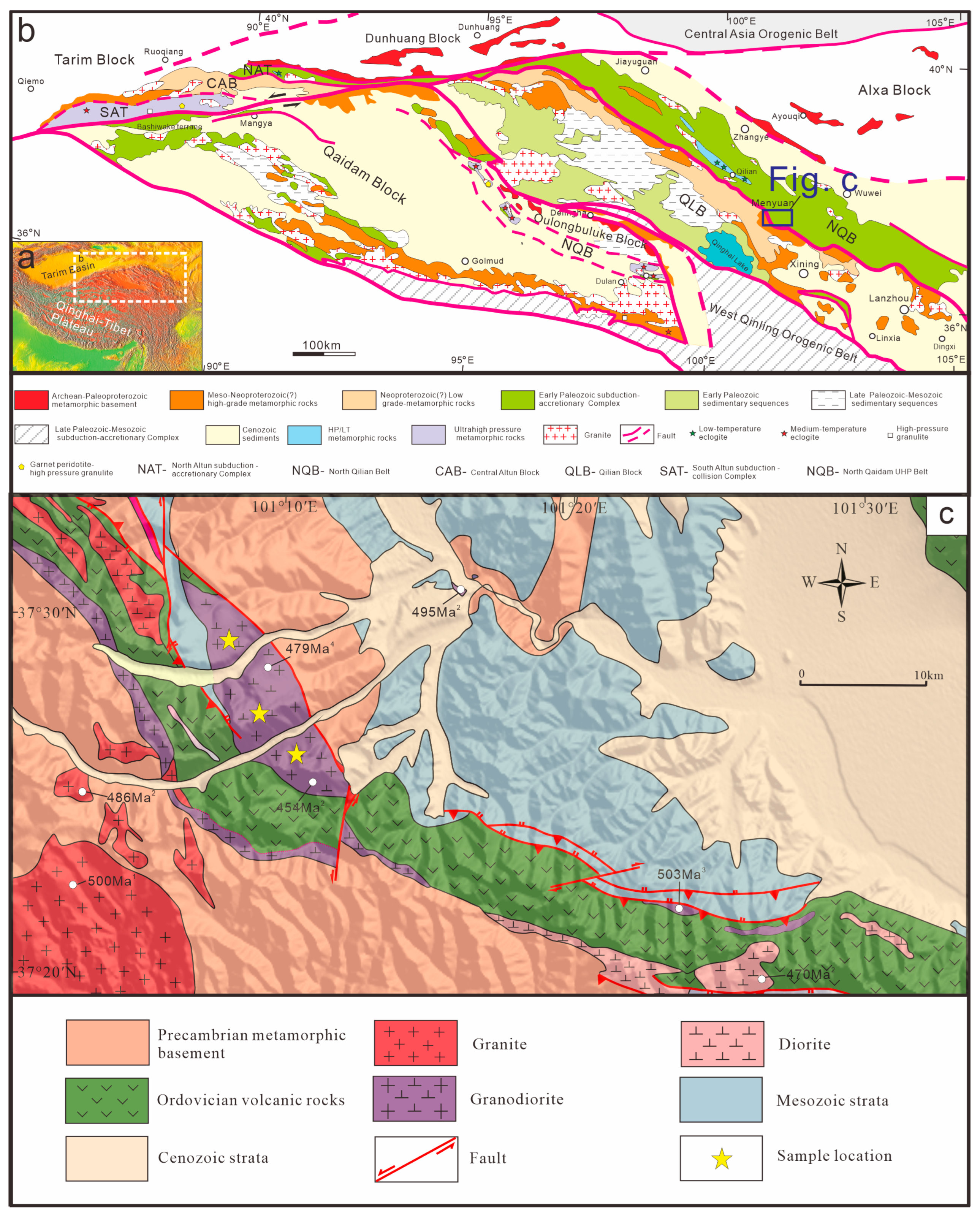
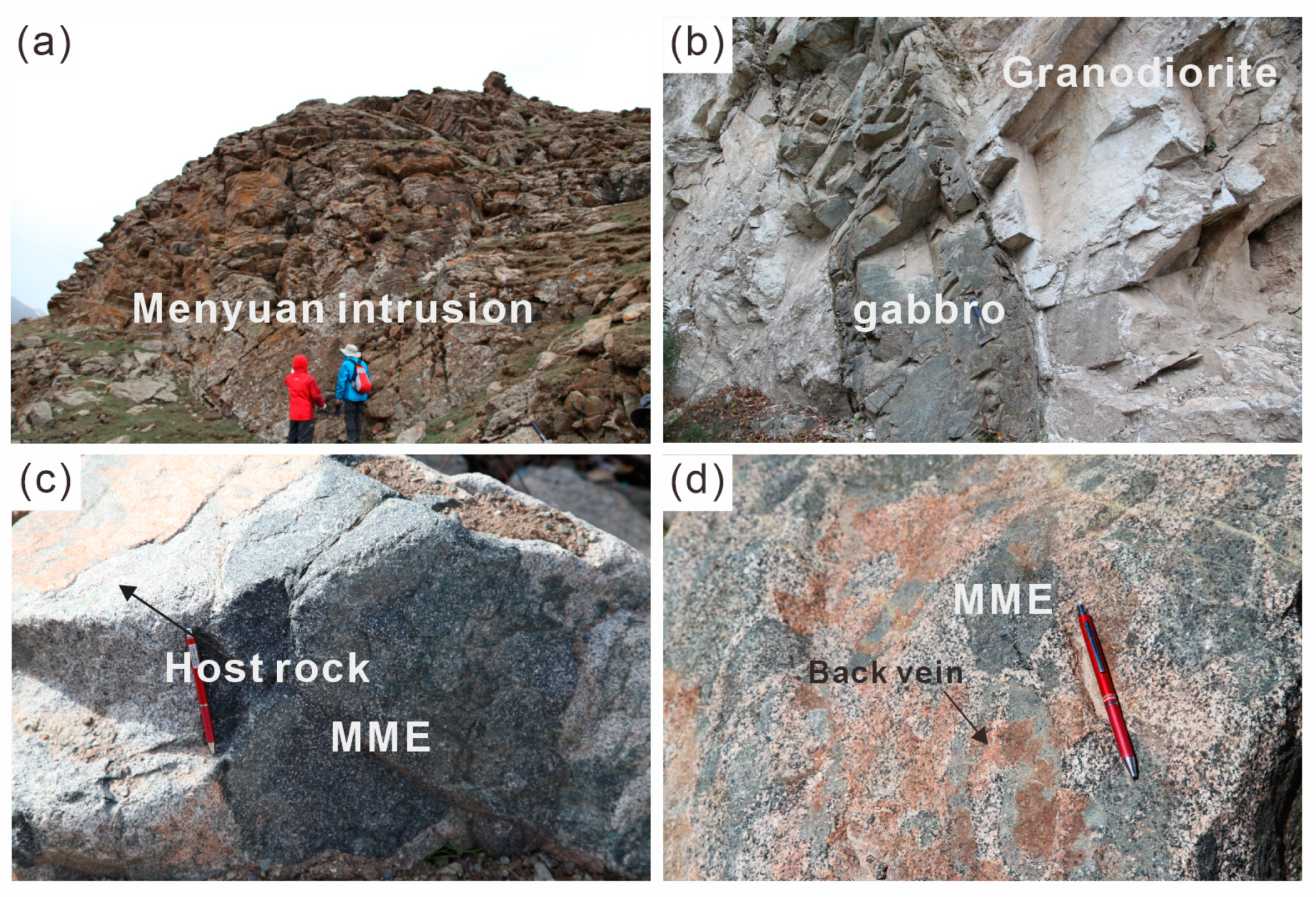
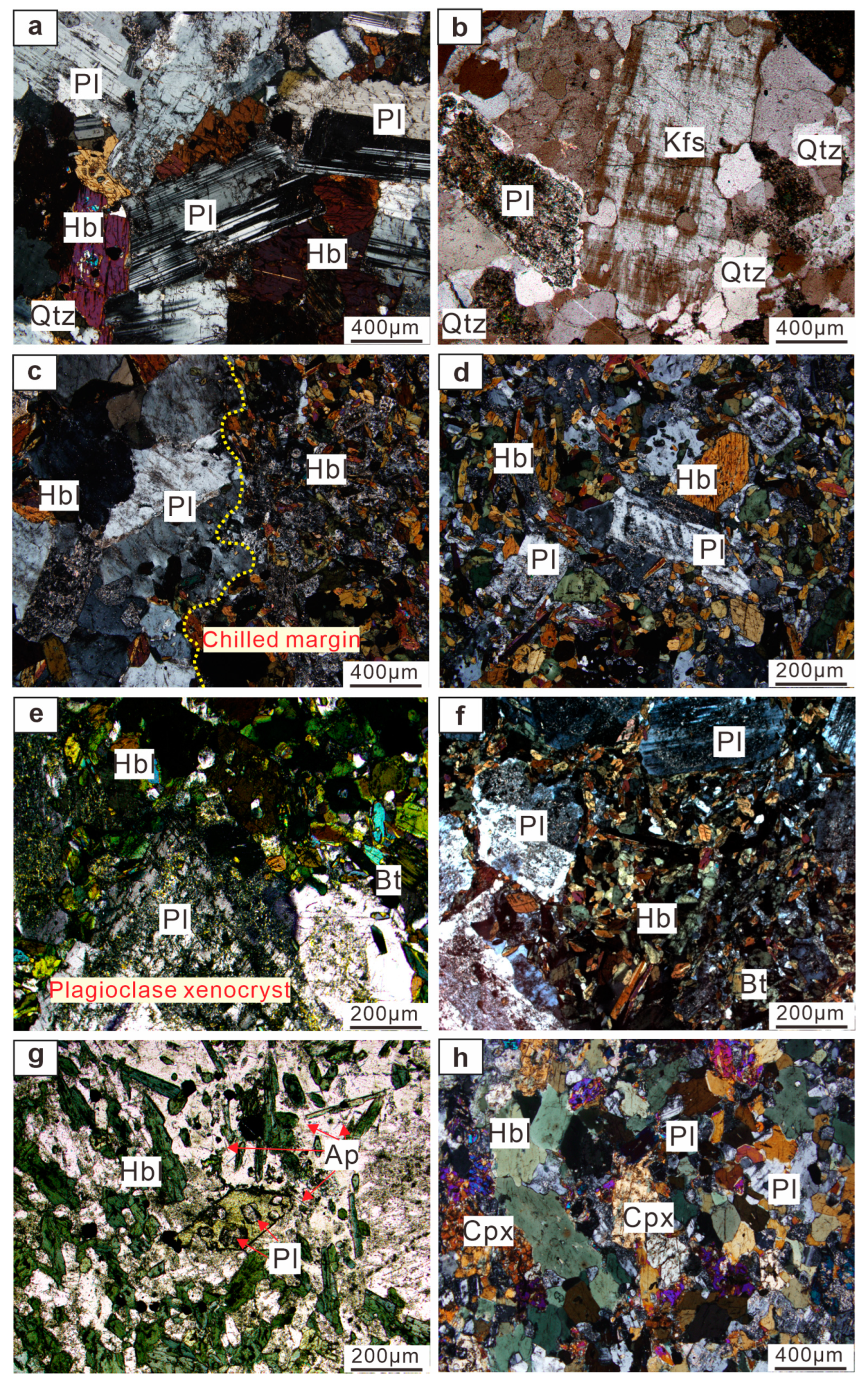
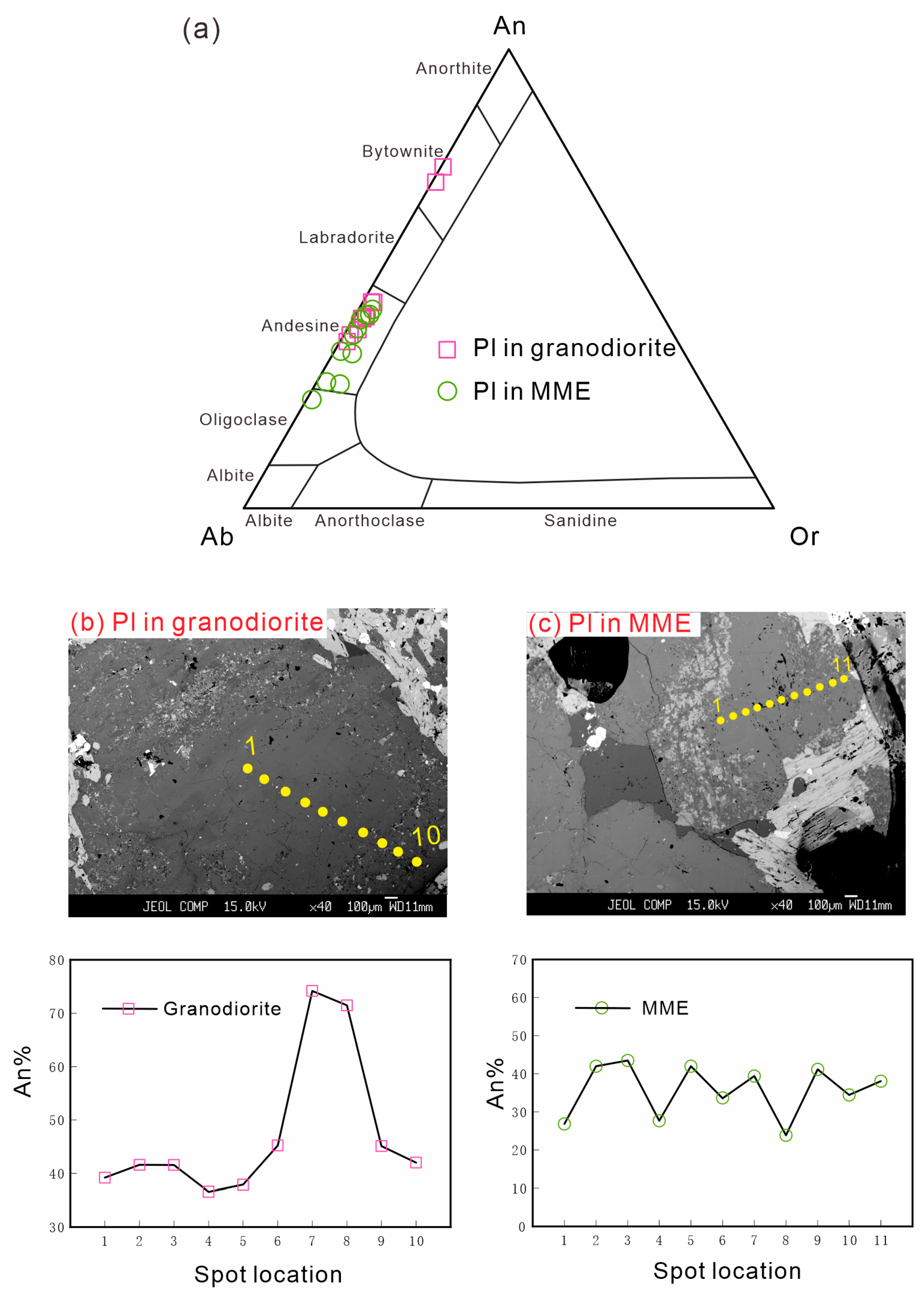

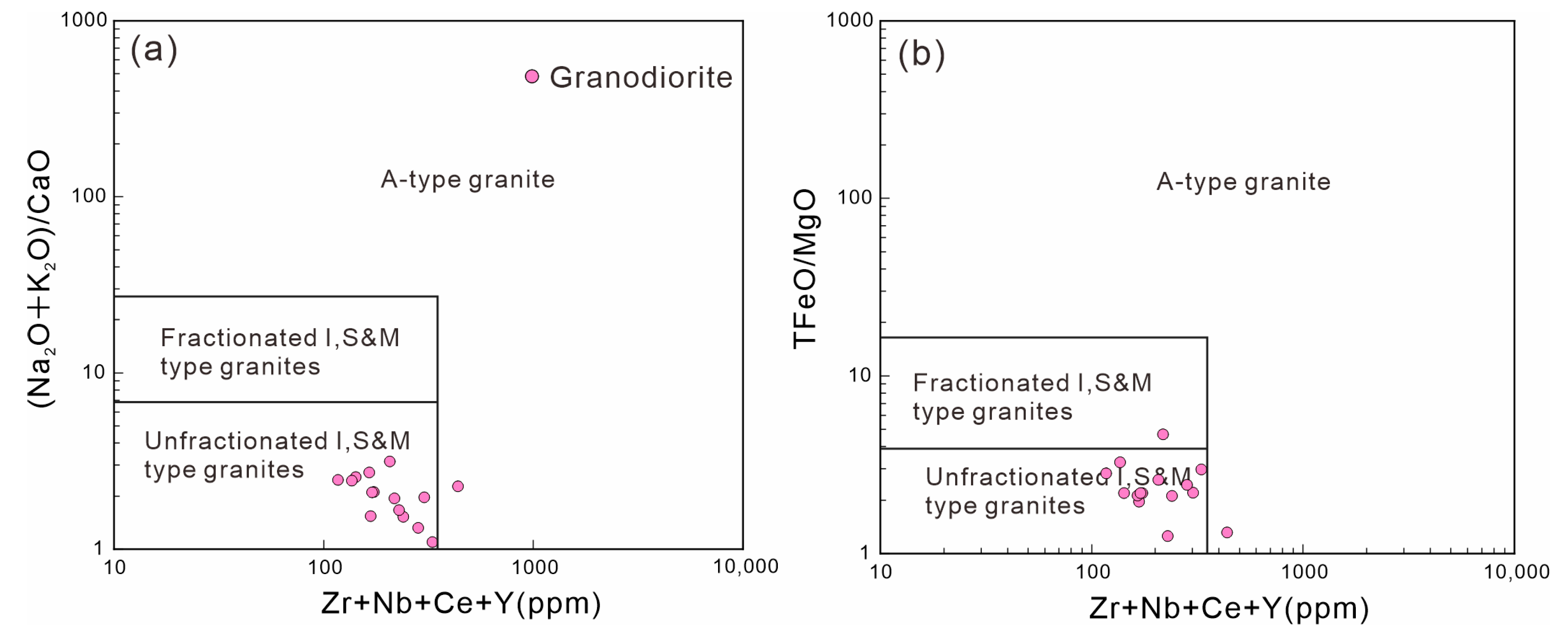

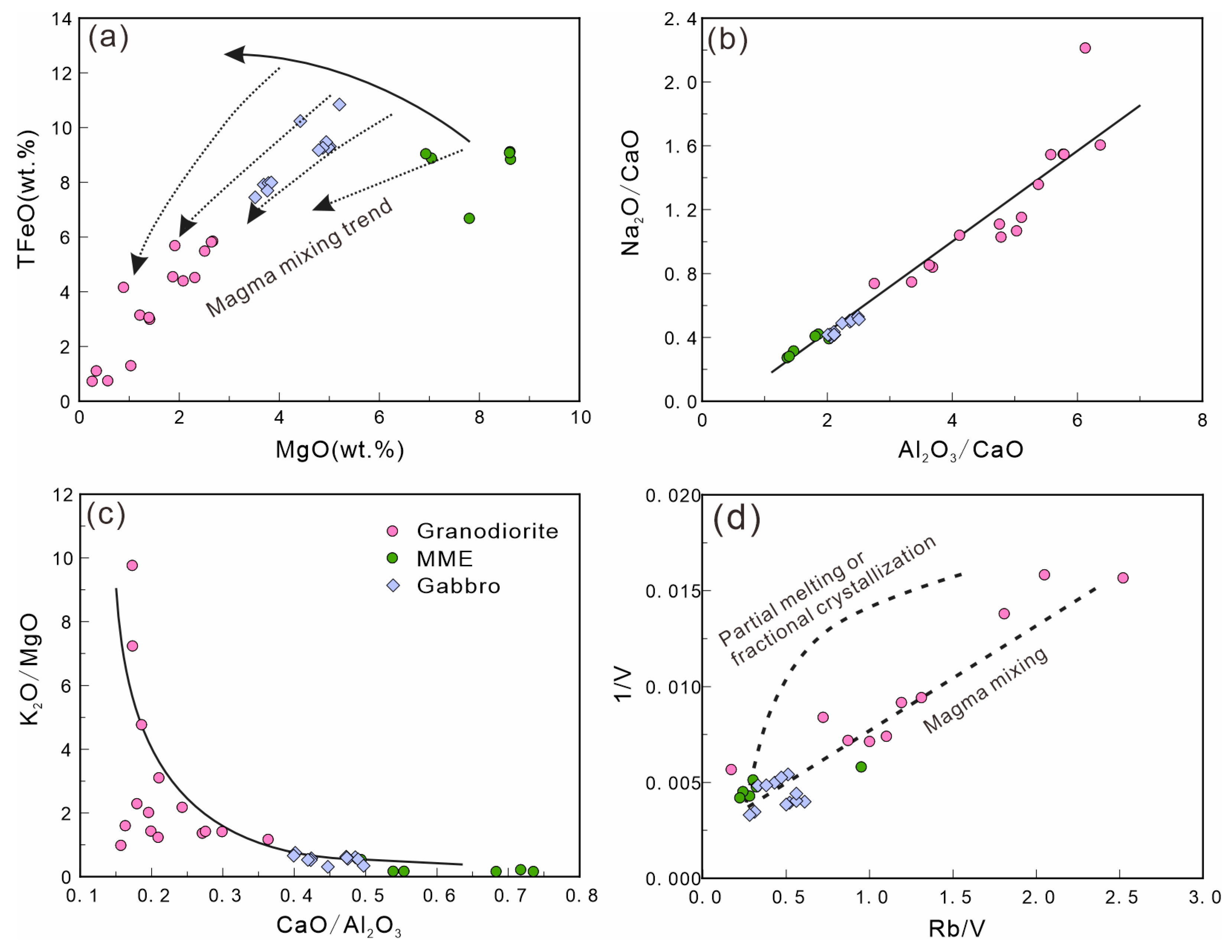
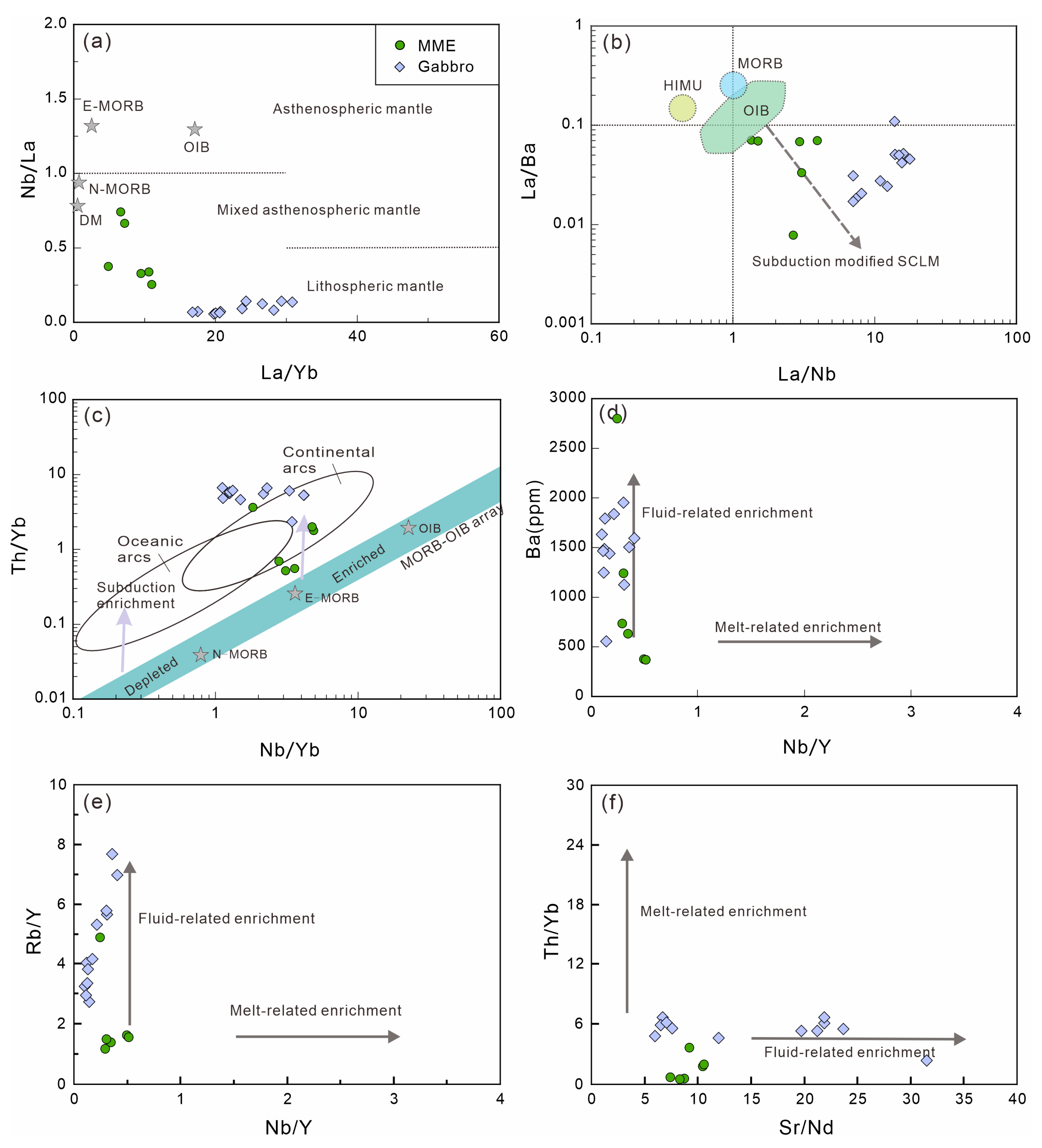
Disclaimer/Publisher’s Note: The statements, opinions and data contained in all publications are solely those of the individual author(s) and contributor(s) and not of MDPI and/or the editor(s). MDPI and/or the editor(s) disclaim responsibility for any injury to people or property resulting from any ideas, methods, instructions or products referred to in the content. |
© 2025 by the authors. Licensee MDPI, Basel, Switzerland. This article is an open access article distributed under the terms and conditions of the Creative Commons Attribution (CC BY) license (https://creativecommons.org/licenses/by/4.0/).
Share and Cite
Xia, S.; Qi, Y.; Yu, S.; Jiang, X.; Gao, X.; Wang, Y.; Li, C.; Wang, Q.; Wang, L.; Peng, Y. Magma Mixing Origin for the Menyuan Granodioritic Pluton in the North Qilian Orogenic Belt, China. Minerals 2025, 15, 391. https://doi.org/10.3390/min15040391
Xia S, Qi Y, Yu S, Jiang X, Gao X, Wang Y, Li C, Wang Q, Wang L, Peng Y. Magma Mixing Origin for the Menyuan Granodioritic Pluton in the North Qilian Orogenic Belt, China. Minerals. 2025; 15(4):391. https://doi.org/10.3390/min15040391
Chicago/Turabian StyleXia, Shugang, Yu Qi, Shengyao Yu, Xiaocong Jiang, Xiangyu Gao, Yue Wang, Chuanzhi Li, Qian Wang, Lintao Wang, and Yinbiao Peng. 2025. "Magma Mixing Origin for the Menyuan Granodioritic Pluton in the North Qilian Orogenic Belt, China" Minerals 15, no. 4: 391. https://doi.org/10.3390/min15040391
APA StyleXia, S., Qi, Y., Yu, S., Jiang, X., Gao, X., Wang, Y., Li, C., Wang, Q., Wang, L., & Peng, Y. (2025). Magma Mixing Origin for the Menyuan Granodioritic Pluton in the North Qilian Orogenic Belt, China. Minerals, 15(4), 391. https://doi.org/10.3390/min15040391









